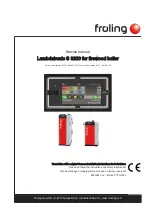
7
VI Venting
WARNING
Failure to vent this boiler in accordance with these instructions could result in unreliable boiler
operation, severe damage to the boiler or property, personal injury or death:
* Do not attempt to vent this boiler with galvanized, PVC, or any other vent system not listed in Table 4.
* Do not attempt to mix components from different approved vent systems.
* Do not obtain combustion air from within the building.
* Do not install a barometric damper or drafthood on this boiler.
* The vent system for this boiler must not be shared with any other appliance.
* Moisture and ice may form on the surfaces around the vent termination. To prevent deterioration,
surfaces should be in good repair (sealed, painted, etc.)
A. Vent System Design
There are four basic ways to vent this boiler:
• Horizontal (“Side Wall”) Twin Pipe Venting
- Vent system exits the building through an outside wall.
Combustion air and flue gas are routed between the boiler and outdoors using separate pipes.
• Vertical Twin Pipe Venting
- Vent system exits the building through a roof. Combustion air and flue gas are
routed between the boiler and outdoors using separate pipes.
• Horizontal (“Side Wall”) Concentric Venting
- Vent system exits the building through an outside wall.
Concentric venting consists of a “pipe within a pipe”. Flue gas exits the building through the inner pipe and
combustion air is drawn into the boiler through the space between the inner and outer pipe.
• Vertical Concentric Venting -
Vent system exits the building through the roof. Concentric venting consists of a
“pipe within a pipe”. Flue gas exits the building through the inner pipe and combustion air is drawn into the boiler
through the space between the inner and outer pipe.
All of these systems are considered “direct vent” because in all of them air for combustion is drawn directly from
the outdoors into the boiler.
A description of each of these venting options is listed in Tables 6.1 and 6.5. For
clarity, these vent options are numbered from 1 to 10.
One of the vent option columns in Table 6.1 or in Table
6.5 must match the planned vent and air intake system exactly.
In addition, observe the following guidelines:
1) Approved vent systems
- Use only one of the approved vent systems shown in Tables 6.1 or 6.5. These vent systems
fall into two basic categories:
•
Twin Pipe Vent Systems
- The standard approved vent systems are made of a special stainless steel alloy (AL29-
4C) for protection against corrosive flue gas condensate. They are designed to provide a gas tight seal at all
joints and seams so that flue gas does not enter the building. Each approved vent system has a unique method for
installation
- do not attempt to mix components from different vent systems
. A list of approved twin pipe vent
systems is shown in Table 6.4.
•
Concentric Vent System
- The concentric vent system may only be used on the T300. Each Triad concentric
vent component consists of an inner pipe of polypropylene and the outer pipe of steel. Integral gaskets on each
concentric fitting provide a gas tight seal. In this manual, concentric pipe sizes are called out in terms of the inner
and outer pipe nominal diameters in millimeters. For example“100/150mm” pipe consists of a 100mm exhaust
pipe inside a 150mm diameter outer pipe. A list of all Triad concentric vent components is shown in Table 6.10.
The T399 and T425 are supplied with stainless steel vent collar and a separate air intake collar for twin
pipe venting. The T300 may be supplied with either a stainless steel vent adaptor kit (P/N 230557) for twin
pipe venting or a concentric vent adaptor kit (P/N 230556) for concentric venting.
2) Maximum Vent and Air Intake Lengths
- The maximum length of the vent air intake piping depends upon the vent
option selected and the boiler size. See Tables 6.1 and 6.5 for the maximum vent lengths. All vent lengths shown in
Tables 6.1 and 6.5 are in addition to one 90° elbow and the termination fitting.
Содержание Triumph series
Страница 2: ......
Страница 31: ...29 FIGURE 6 21b CUTTING VERTICAL TERMINAL FIGURE 6 21c COMPLETING VERTICAL TERMINAL INSTALLATION ...
Страница 34: ...32 FIGURE 6 23 CONDENSATE PIPING ARRANGEMENT ...
Страница 48: ...46 Figure 8 14 Multiple Boiler Piping ...
Страница 50: ...Figure 9 1 Wiring Connections Diagram 48 ...
Страница 51: ...Figure 9 2 Ladder Diagram 49 ...
Страница 69: ...67 PAGE INTENTIONALLY LEFT BLANK ...
Страница 71: ...69 ...
Страница 72: ...70 ...
Страница 73: ...71 ...
Страница 75: ...73 ...
Страница 76: ...74 ...
Страница 78: ...76 ...
Страница 79: ...77 ...
Страница 82: ...80 ...
Страница 83: ...81 155 156 158 157 160 159 ...
Страница 84: ...82 161 162 164 163 166 165 ...
Страница 85: ...83 167 ...










































